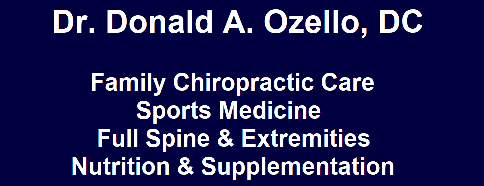Combine proper nutrition with regular chiropractic care to lessen the frequency and severity of asthma symptoms. In this four part series I discuss how regular chiropractic care can help asthma sufferers better manage their condition.
In part one, I provided an overview of asthma and chiropractic care. In part two, I discussed specific ways chiropractic treatment helps those with asthma. In part three, I give nutritional information to better manage asthma symptoms. Part four contains lifestyle strategies to help asthma sufferers prevent attacks and better control their symptoms.
Disclaimer: Chiropractic care and nutrition are not cures for asthma. Chiropractic treatment may help decrease the severity and lessen the frequency of asthma symptoms by optimizing nerve flow and re-establishing proper skeletal motion. There is no specific anti-asthma diet. The following nutritional strategies are suggestions that may help reduce inflammation and decrease the intensity and occurrence of asthma attacks. Chiropractic treatment and nutrition do not replace the use of an inhaler during an asthma attack.
Inflammation is an integral part of the immune response. Acute inflammation is a defense mechanism necessary for survival in cases of infection and injury. Chronic and systemic inflammation leads to disease and symptoms.
Asthma is characterized by airway obstruction and inflammation. Asthma is often described as a chronic inflammatory disease of the airways.
Sound nutritional strategies are the best defense against disease causing inflammation. The body responds to food by producing anti-inflammatory or pro-inflammatory chemicals named prostaglandins. An imbalanced intake between pro-inflammatory and anti-inflammatory producing foods results in chronic and systemic inflammation.
Increase your consumption of anti-inflammatory foods and decrease your intake of inflammation producing foods to reduce your inflammation levels. Foods containing omega-3 fatty acids including salmon, albacore tuna, trout, walnuts, pumpkin seeds, olive oil and primrose oil reduce inflammation. Foods which increase inflammation include saturated fats, hydrogenated fats, Trans fats, butter, vegetables oils and highly processed foods.
Choose anti-inflammatory foods over pro-inflammatory foods to decrease inflammation and better manage your asthma symptoms.
Consume foods that contain antioxidants to boost your immunity. Antioxidants are substances that render disease causing free-radicals harmless. Antioxidants fight disease and decrease inflammation.
Strengthen your immune system by eating five to nine servings of fruits and vegetables daily. Fruits and vegetables rich in antioxidants come in an array of colors. Each color contains a different mix of nutrients. Choose a variety of different colored fruits and vegetables for best results.
In my professorial clinical experience, I’ve observed asthma symptoms triggered by the following foods and drinks: Citrus fruits, carbonated beverages, soft drinks, alcohol, dairy products, nightshades, peanuts and pickled foods. I’ve also observed food additives or chemicals trigger asthma attacks.
These symptoms often occur immediately. Other times the symptoms take longer to appear and may be less intense. Record a detailed dietary journal to note the occurrence of symptoms after meals. Avoid specific foods and food additives that trigger any asthma symptoms.
Food allergies can cause a wide spectrum of disorders and symptoms. Food allergy symptoms can be intense or mild. Food allergies may be the reason that trigger foods cause asthma symptoms.
Identification of food allergies may be difficult but it is not impossible. The easy tool to determine food allergies is a dietary journal. Simply record detailed information on the foods and beverages you consume and your body’s reactions. Note the exact amounts, the combinations of foods, how they’re prepared and other information you feel is pertinent.
Review the recorded information and eliminate any foods that elicit asthma or pre-asthma symptoms. Reduce or eliminate any foods that elicit symptoms of any kind including sleepiness, headache, pain, skin rash or itchiness.
Common food allergies include nuts, shellfish, dairy and nightshades. Frequently used food additives may be the source of food allergies. Use the information in your dietary journal as a starting point to determine your food allergies. Utilize medical testing to confirm your findings.
Eat a wide variety of healthy foods to lessen the potential of creating new food allergies. Assess the findings in your dietary journal to note frequency of foods. Adjust your nutritional strategies accordingly.
Eliminate or reduce the consumption of any foods that elicit allergic symptoms to improve your health and better manage your asthma symptoms.
Researchers reported that adolescents are more likely to experience respiratory symptoms if their diets are nutrient deficient. Most fast food is high in calories, low in nutrients and filled with chemicals additives. Limit or completely eliminate your intake of fast foods to improve your health. Choose the healthiest, most nutrient dense food available to decrease inflammation and lower the risk of an asthma attack.
Supplements are a fundamental part of healthy dietary strategies. Supplements do not replace food. They fill in the gaps to prevent nutrient deficiencies.
Many disorders are caused by nutrient deficiency or nutrient toxicity. Utilize proper supplementation to combat these disorders. Seek expert assistance from a medical professional who specializes in nutrition or a registered dietician.
Choose supplements which are produced from certified-organic whole foods for best results. These supplements supply micronutrients in the natural balance contained in healthy foods.
In my professional clinical experience, I’ve observed several supplements from Standard Process help asthma sufferers. These include Catalyn, Pheumotrophin PMG and Congaplex.
Prebiotics & Probiotics are supplements which help the digestive process and may help to strengthen the gut lining. Better breakdown and absorption of healthy food increases the body’s ability to utilize the food’s nutrients. These supplements have been shown to help allergy sufferers better control their symptoms.
Intelligent supplementation strategies improve health and help fight disease. Proper utilization of dietary supplements may help asthma and allergy sufferers decrease the severity and frequency of their symptoms.
Diet is definitely associated with asthma. The extent of the connection varies with each individual.
Use general dietary guidelines as a starting point. Individual dietary needs are specific for each individual. Usage of a dietary journal helps to determine what works and doesn’t work for you. Detailed information from a dietary journal provides specific information for your individual nutritional needs.
Choose the healthiest food available. Increase your intake of anti-inflammatory foods and antioxidants to improve health and fight disease. Eliminate foods that elicit asthma or pre-asthma symptoms. Utilize intelligent supplementation strategies to better control your asthma symptoms and prevent nutrient deficiency and toxicity. Avoid fast foods, highly processed foods and foods that produce allergic reactions to control your caloric intake and decrease your ingestion of potential disease causing food additives.
Proper nutrition is vital. Eat nutritious foods to improve your health, fitness and functionality. Combine proper nutrition, regular chiropractic treatment, exercise, reduction of stress and reduction of exposure to toxins to decrease the severity and frequency of asthma attacks and symptoms.
Dr Donald A Ozello DC of Championship Chiropractic in Las Vegas, NV
Web Site: http://www.championshipchiropractic.com/
Blog: https://www.championshipchiropractic.com/wordpress/
YouTube: https://www.youtube.com/user/drdozellodc/videos
Twitter: https://twitter.com/drdozellodc
Facebook: https://www.facebook.com/Championship-Chiropractic-280141628688300/
LinkedIn: https://www.linkedin.com/in/dr-donald-a-ozello-dc-716b3233
“Running: Maximize Performance & Minimize Injuries” https://www.amazon.com/Running-Performance-Chiropractors-Minimizing-Potential/dp/1493618741
**Disclaimer: Always consult a medical professional before beginning an exercise program. Always work within your capabilities. Never perform an exercise that elicits or increases pain or symptoms. Reading this article and viewing the linked videos does not take the place of seeing a medical professional. Please visit a medical professional for evaluation, diagnosis & treatment.

